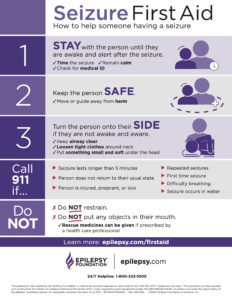Seizure First Aid: Plan and Prepare

The more you know about epilepsy, the better you can attend to the needs of your loved one. It is important to identify a seizure, provide first aid, and adequately support individuals who suffer from this debilitating disorder. A person is diagnosed with epilepsy once they experience two or more seizures. The seizure itself is a change in normal brain activity and the main sign of epilepsy. A focal aware seizure (FAS) commonly develops into another type of seizure and therefore is oftentimes a warning that another seizure is to come.
People who experience FAS describe a feeling of déjà vu, unusual smell or taste, stiffness or twitching in one part of the body, numbness or tingling, visual disturbances, or a sensation that an arm or leg feels bigger or smaller. It is therefore important for people who feel one or all of these to vocalize them to family or friends who are around. Since these feelings aren’t as debilitating as other types of seizures, family/ friends can prepare for an oncoming, more serious seizure.
If you are experiencing one or more of the following signs and symptoms, talk to your doctor.
Signs and Symptoms
Confusion described as ‘fuzzy feeling’
Staring spell
Jerking movement
Loss of consciousness
‘Out of body’ feeling
Memory lapse
According to the Epilepsy Foundation, everyone who suffers from the disorder should have an action plan in case of a seizure. One of the key factors to consider when you are diagnosed with epilepsy is to have a care team or supporters such as friends and family who are aware and trained on what to do in case of an emergency. The Epilepsy Foundation suggests doing “seizure drills” to practice what to do and how to give rescue treatments. Epilepsy is the fourth most common neurological disorder and affects nearly 65 million people around the world. Let’s work together to support those impacted by the disorder and improve their quality of life.

